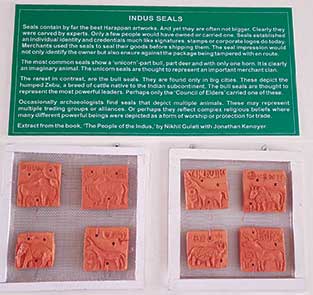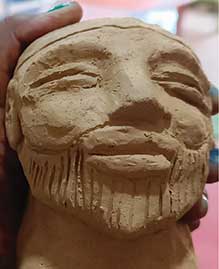Soma Chakraborty
Students of grade VI have a lesson on the Indus valley civilization in their history syllabus. As part of integrating art into the teaching-learning process, they were made to create Harappan toys and seals in their clay classes.
Anjali was always interested in attending art and clay classes. Every week she would enthusiastically show me her clay work and wait for me to tell her that she has done a “good job”.
We at Delhi World Public school, Bangalore, use art as one of the mediums of teaching-learning in all subjects. At the end of the year, students’ works of art are displayed in the school art exhibition.

When Anjali saw that her claywork had been framed and showcased as a permanent display in the school, her emotions ran high. Next morning when she saw me and a few other teachers appreciating her artwork on the school wall, she was elated. She came to me during the lunch break to tell me that she was very happy because that was the first time that teachers were praising her. She was new to Delhi World Public school, and was never exposed to clay work and therefore had only just found her interest in making clay models.
Anjali has a learning disability and struggles to cope with scholastic areas and score the minimum passing marks. We are required to take two to three remedial classes every week for children with learning difficulties during the co-curricular periods. Anjali would happily trade the sports periods for remedial classes.
She is a visual learner and understands better when she draws or creates things. Anjali was therefore ecstatic to hear the teachers praise her clay work and recognize her talent. After the art week, all the children were issued certificates and appreciated in the school assembly. These small “carrots” went a long way in developing her intrinsic motivation. Before the annual exams, whenever I asked her a question she would scribble a drawing and try to tell the answer using it.
She sometimes showed signs of attention deficiency, but for her clay and artwork. Initially, Anjali used to sit in a corner of the class and not interact much with her peers, but after the art week we found that there was a noticeable change in her personality. She started interacting with her peers and befriending them.
She slowly started opening up and talking about her emotions to the teachers. She now feels comfortable and secure in the school environment.
Aware of her disability and poor grades, her parents were always reluctant to come to the parent-teacher interactions. After the final exams, the results were distributed to the students and parents. We met Anjali’s parents and counselled them to focus on her strengths and not weaknesses and that she could always choose clay or art as her career. As she was getting ready to leave the classroom, Anjali asked me if she could come to school during the holidays and do more clay work. I had to tell her that we were also looking forward to more of her clay work in the next academic year, but that she needed to practice her art at home for now.
The world is a magnanimous stage and every human has a part to play. Not every child needs to become a teacher, or a doctor, or an engineer. They can be nurtured to learn other skill sets. Most importantly, they too yearn for a hug or an appreciation like you and me.

Going back in history, Leonardo da Vinci suffered from as many learning disabilities as he had talents. He was as much a scientist as he was an artist. His study of anatomy, zoology, botany, geology, optics, aerodynamics was by way of paintings. Experts believe he showed signs of dyslexia, ADHD (Attention Deficit Hyperactivity Disorder), and other learning disorders and attention issues.
Historians say that Mughal emperor Akbar also had learning disabilities. He was unable to read and write and hence insisted that his minister Abul Fazal read and write on his behalf. He promoted art and miniature paintings during his reign not just because he wanted to be a patron of art but because he understood pictorial representations better than the written word. His disabilities did not deter him from being an efficient ruler and able administrator.
More recently, film stars like Hrithik Roshan and Abhishek Bachchan have also admitted that they suffered from learning disabilities. Films like Taare Zameen Par have helped create awareness about mental disabilities.
It is wrong to assess every child with the same parameters. A child with a learning disability may be average in studies but very good at sports, fine arts, music, or architecture. In our school, we design a different question paper for children with learning disabilities in which there are no essay type questions, instead we have questions that are based on pictures, charts, maps, or match the following. Apart from this, they also have non pencil and paper tests in which they make a model or draw a picture and speak about it.
Let us teachers be an instrument of change. Let us identify and encourage our ‘special’ students to learn new skills and excel at them. Motivate and encourage to bring out the Akbar or Da Vinci in them.
Inclusion of a child with mental or physical disability in the social framework reduces his or her dependency and develops independence, confidence, and emotional wellbeing. If every citizen takes one step to bring change, the world will surely be a better place to live in.
I would like to conclude with a line from the poem Ode to the West Wind.
If winter is here, can spring be far behind.
References
• https://www.jefferson.edu/university/news/2019/05/7/dyslexia-helped-leonardo-davinci.html#:~:text=%E2%80%9CDyslexia%20is%20probably%20one%20of,Medical%20College%E2%80%94Thomas%20Jefferson%20Universary
• https://varnikadesigns.wordpress.com/2015/07/10/akbar-and-dyslexia/
The author teaches social science at Delhi World Public school, Bengaluru. She can be reached at soma.chakraborty09@gmail.com.
